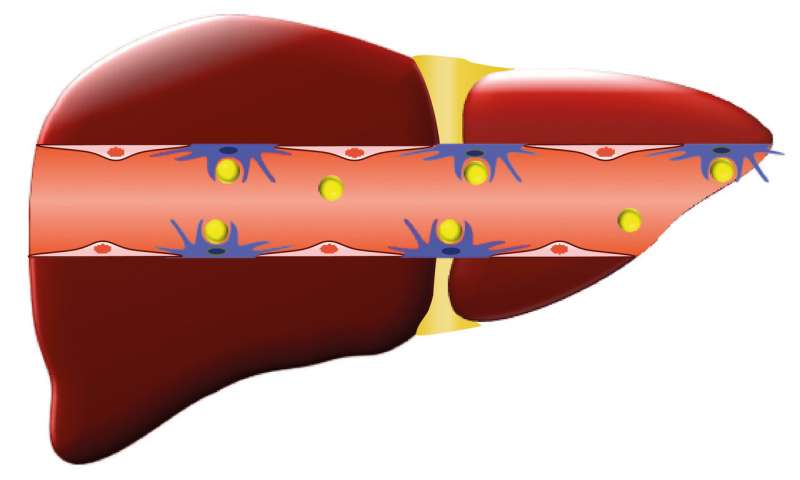
A study by researchers at the MRC Toxicology Unit has provided strong evidence that certain carbon nanotubes used in manufacturing could pose the same cancer risk as asbestos.
As well as highlighting potential risks to those exposed to carbon nanotubes, their findings, published today in Current Biologyopens in new window, have also given new insights into how the disease develops. This is important because mesothelioma, for which there is currently no cure, often remains undiagnosed for decades. Knowing more about its very early stages could one day lead to earlier diagnosis and more effective therapies.
Carbon nanotubes (CNTs) are a form of carbon which have a long, hollow structure with a diameter as small as a few nanometres (around one-billionth of a metre, or about 10,000 times smaller the diameter of a human hair) but up to several centimetres long. They are used in the manufacture of incredibly strong but lightweight materials. Commercial uses include: special paints; sports equipment such as bicycle frames and tennis racquet handles; boat hulls; aircraft; sports cars; and computer motherboards.
Some CNTs are similar in size and shape to asbestos fibres, leading researchers to question whether they might have the same harmful effect on our lungs.
Previous studies have looked at the effect of introducing the fibres directly into the abdominal cavity of mice. In this new study, the researchers placed either long carbon nanotubes or asbestos fibres directly into the pleural space, which separates the lungs and chest wall, where mesothelioma usually develops in humans. This far more closely mimics occupational exposure where free fibres might be inhaled during the manufacturing process. (There is no evidence of risk from finished products which incorporate CNTs.)
The researchers studied the changes these caused in the cells lining this space over a number of months. The mesothelioma which developed in the mice after asbestos or CNT exposure was similar to mesothelioma samples from patients exposed to asbestos.
They found that, like asbestos fibres, long nanotubes caused long-term inflammation in the pleural space. Over time, this inflammation led to inactivation and loss of the specific genes that suppress the formation of tumours which, in people with mesothelioma, are also found to be altered.
In humans, if mesothelioma does develop after exposure to asbestos, it can take an extremely long time, up to 40 years, and people are often unaware they have been exposed. This makes it very difficult to obtain lung tissue to study exposure-related changes. Mice are a good experimental model because they have an average lifespan of two to three years and develop disease within 2 years, allowing disease progression to be monitored from the start of exposure.
“Unlike previously reported short-term studies, this is the first time the mesothelioma-causing effects of long and thin carbon nanotubes have been monitored in mice over many months,” said the study’s senior author, Professor Marion MacFarlane from the MRC Toxicology Unit. “Because it is diagnosed in humans when it’s quite advanced, we don’t know much about how or why it forms. This research could help us define key indicators for early detection as well as provide information for developing targeted therapies for this devastating disease.”
Importantly, the new study found that it was only CNTs which were long, thin and bio-persistent (those which aren’t broken down and expelled by the immune system) which posed a hazard.
“Long, thin nanotubes have a very similar structure to asbestos,” said Professor Anne Willis, director of the MRC Toxicology Unit and the study’s co-author. “The immune system does a good job of recognising shorter, thicker, or tangled up nanotubes. Special cells break down these types of fibre and clear them out of the body, so not all nanofibres pose a hazard.
“We want our research to inform manufacturers and regulators about safer options and contribute to a ‘Safe by Design’ approach when a nanofibre is being selected for the production of nanomaterials for emerging technologies.”
Dr Nathan Richardson, Head of Molecular and Cellular Medicine at the MRC, which funded the research, said “Asbestos-related mesothelioma diagnoses have risen significantly since the 1990s, but are projected to fall steadily in the UK over the next couple of decades – thanks to greater awareness of the dangers, banning much of its use and improved health and safety measures where people can become exposed. As products using CNTs become more popular, we need to make sure that safety regulators are informed about any possible dangers.
“This is an important study in mice, and we now need to better understand real-world exposures to CNT in humans and whether we see any similar molecular changes that might lead to disease. These studies will also help inform human studies on asbestos exposure and disease and perhaps develop earlier diagnostics and effective treatments.”
Learn more: Carbon nanotubes may pose cancer risk similar to asbestos – and we think we know how
The Latest on: Carbon nanotubes
[google_news title=”” keyword=”carbon nanotubes” num_posts=”10″ blurb_length=”0″ show_thumb=”left”]- Nanotubes, nanoparticles and antibodies detect tiny amounts of fentanylon May 2, 2024 at 1:22 pm
A research team at the University of Pittsburgh led by Alexander Star, a chemistry professor in the Kenneth P. Dietrich School of Arts and Sciences, has developed a fentanyl sensor that is six orders ...
- Single-walled carbon nanotubes doped with 'nitrogen' enhance the performance of secondary battery anodeon April 24, 2024 at 9:27 am
Researchers have developed a new manufacturing technique for "silicon/nitrogen-doped carbon composite anode materials." These materials aim to enhance the capacity and stability of lithium-ion battery ...
- Single-walled carbon nanotubes doped with ‘nitrogen’ enhance the performance of secondary battery anodeon April 24, 2024 at 6:04 am
Development of Si alloy/nanocarbon composite anode materials that overcome the limitations of silicon using “nitrogen-doped carbon nanotubes” and “graphene” by KERI. Dr. Han Joong Tark and ...
- Carbon Nanotubes Market Size, Opportunities, Share, Growth, Regional Trends, Key Segments, Graph and Forecast to 2028on April 23, 2024 at 10:35 am
Carbon Nanotubes Market by Type (Single Walled & Multi Walled), End Use Industry (Electronics & Semiconductors, Chemical Materials & Polymers, Structural Composites, Energy & Storage, Medical), Method ...
- Scientists stencil-paint carbon nanotube components for flexible transparent electronicson April 23, 2024 at 9:23 am
Researchers from Skoltech, MIPT, and elsewhere have found a fast and inexpensive way to create geometric patterns in carbon nanotube films. The resulting films turned out to have superior properties ...
- How to ensure readiness of next-generation defense technology: Solving the issue of massive heat.on April 22, 2024 at 7:33 am
High-performance systems generate tremendous amounts of heat that can compromise missions and make high-tech systems less effective in tactical environments. But there is a solution to this modern-age ...
- What Is Carbon? Life's Most Crucial Element, Explainedon April 22, 2024 at 4:00 am
Carbon is found in cellulose and lignin, the structural polymers of plants, as well as the DNA they use to live, grow and reproduce. Carbon is also found in the functional proteins that let this ...
- This electrode material allows 33x more energy storage in wearableson April 21, 2024 at 5:25 am
Fiber-like electrodes with exceptional strength, lightness, and flexibility, promises improved energy storage in wearable devices.
- SiAT Partners with Zeon to Launch Innovative SWCNT Conductive Paste, Enhancing Battery Fast Charging and Energy Densityon April 17, 2024 at 8:00 pm
This collaboration marks the introduction of single-walled carbon nanotube conductive paste. The product can replace or be combined with carbon black to serve as a conductive agent additive in Lithium ...
- Carbon Nanotubes: a blessing or a curse?on April 17, 2024 at 6:09 am
Many decision-makers find it difficult to realistically assess the opportunities and risks of carbon nanotubes, or CNTs for short. A white paper by Fraun - hofer IPA and other experts provides the ...
via Google News and Bing News










